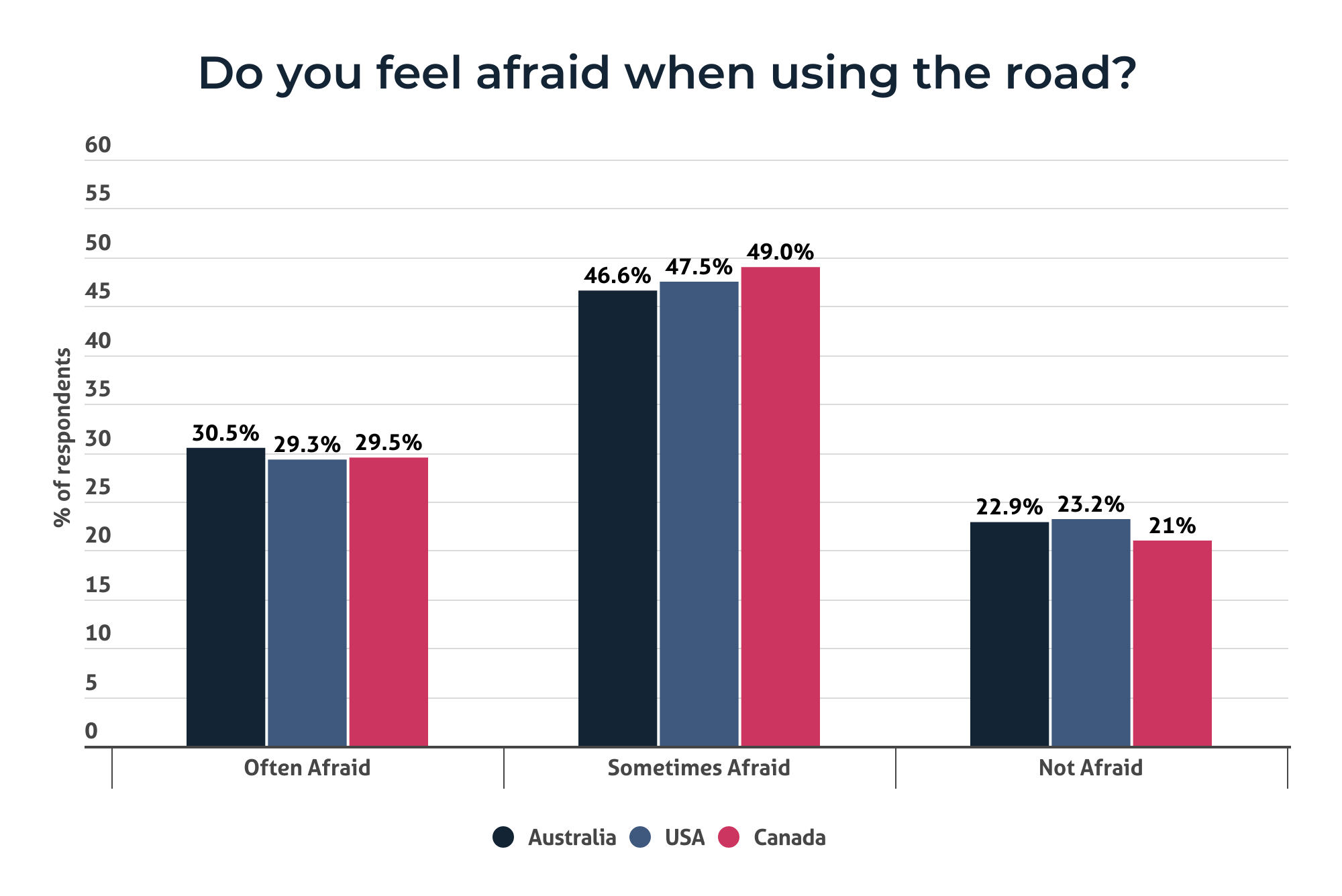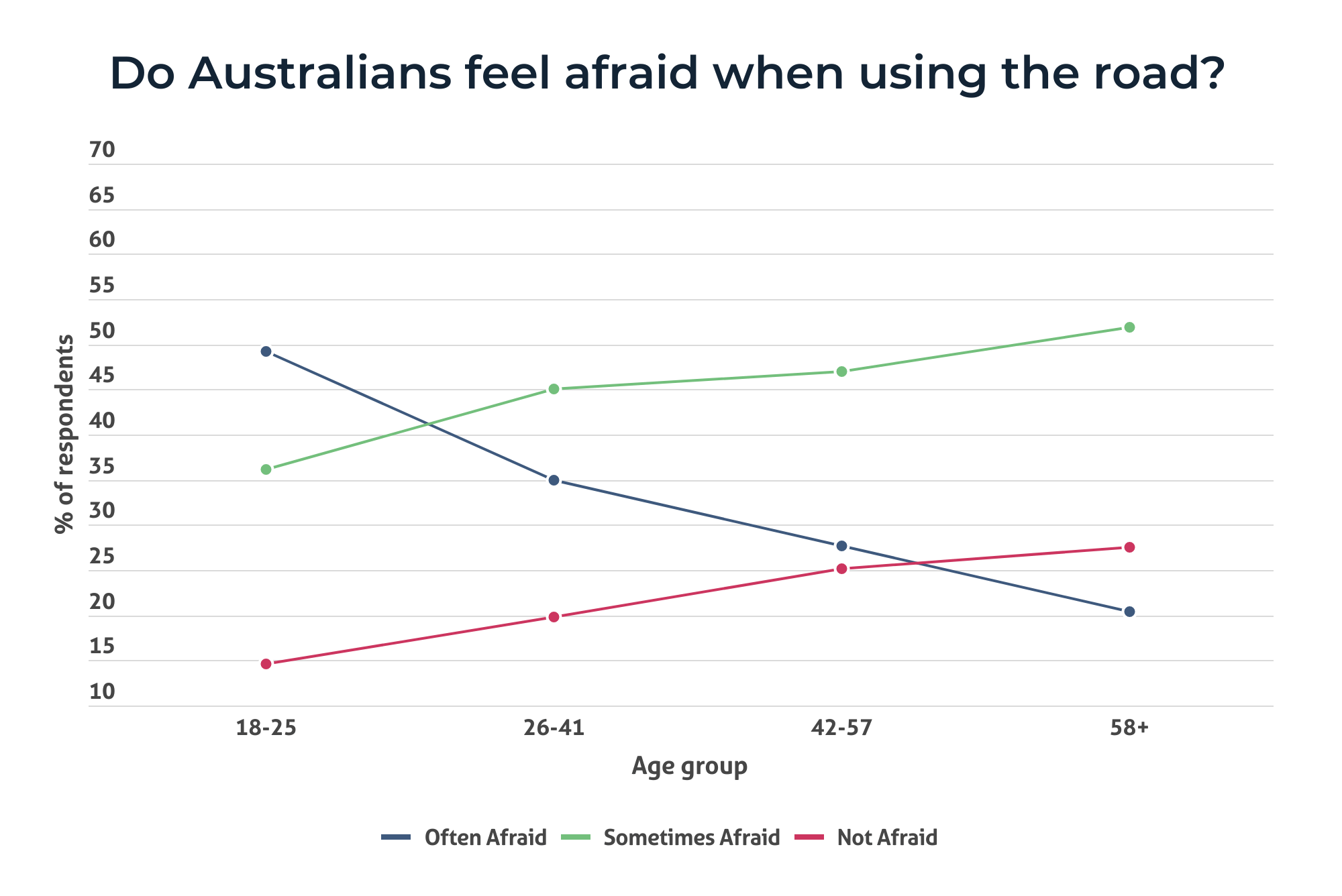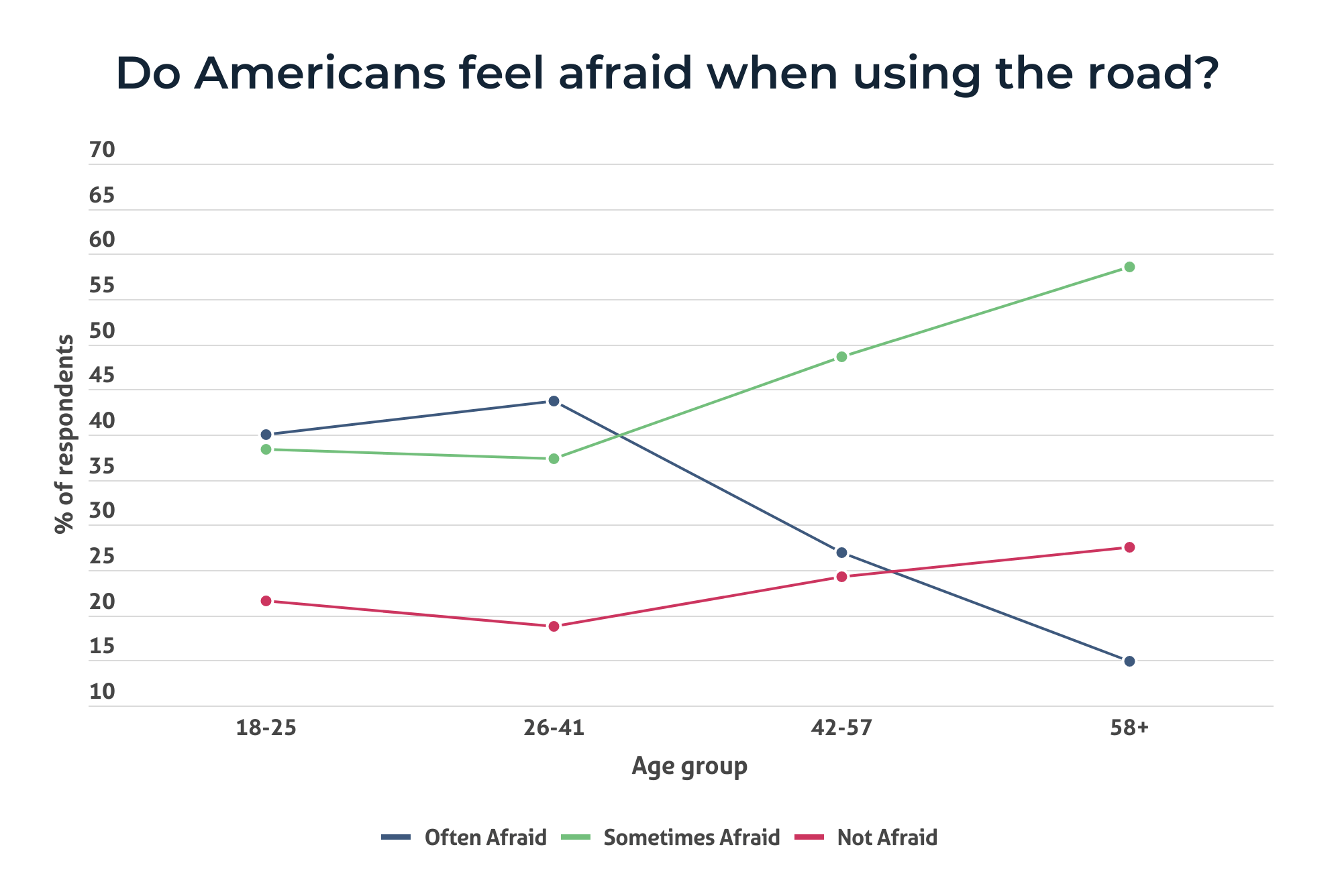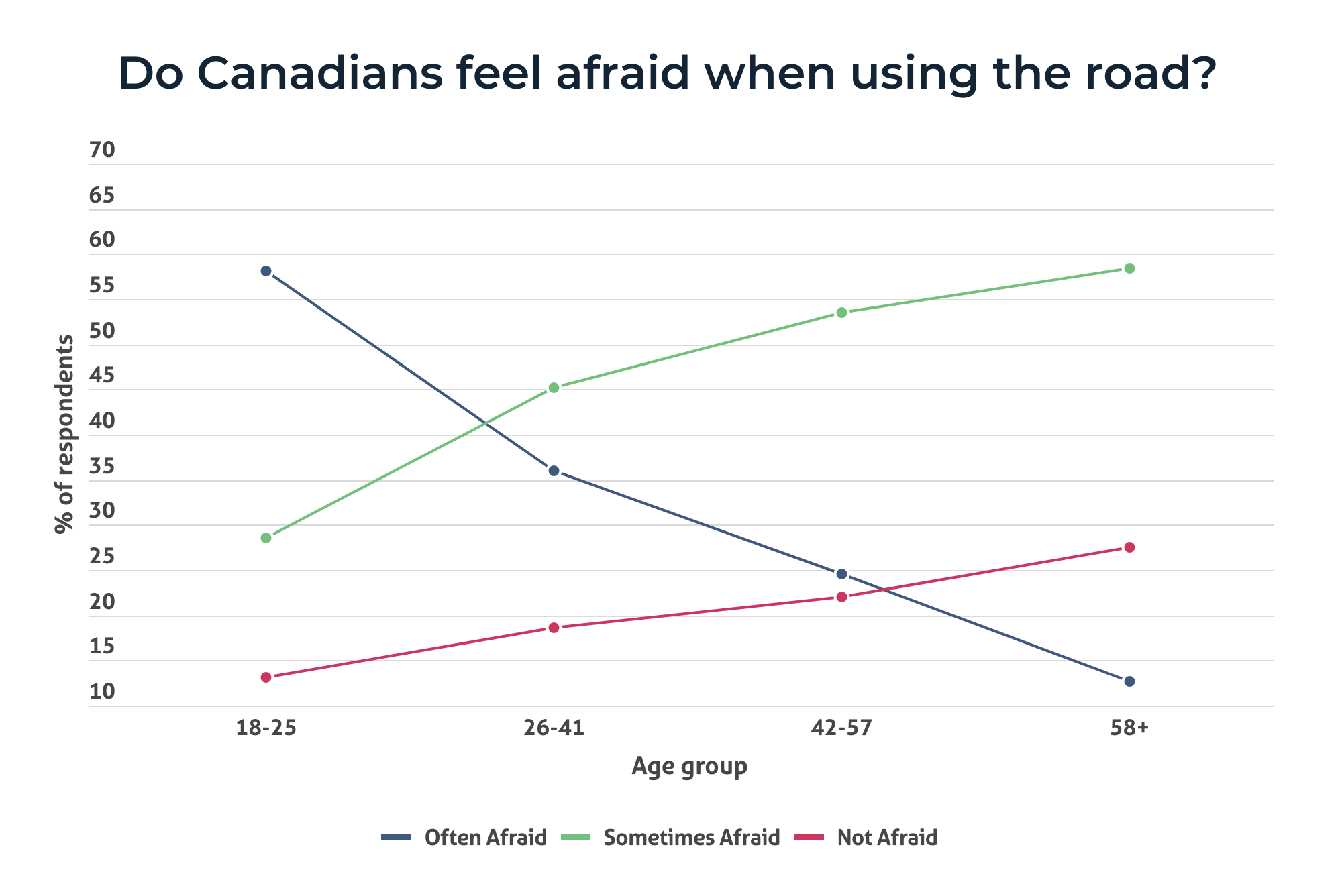The Burrow

Using the road is essential for transport and travel, but for some it can be a stressful and intimidating experience.
As car insurance experts, we wanted to understand how comfortable people are on the roads, and what they’re afraid of when they drive. We commissioned a survey of Australians, Canadians and Americans to see what they’re afraid of when they get behind the wheel.
Here are the results.

Almost one in three road users across the countries we surveyed said they often fear something bad will happen when they get on the road. In Australia it was 30.5%, while in Canada it was 29.5% and slightly less in the USA at 29.3%.
The vast majority of people surveyed said they are sometimes afraid – it depends on the situation. This was the case for 46.6% of Australians, 49.0% of Canadians and 47.5% of Americans.
Always feeling comfortable on the road was the least likely answer. Only 22.9% of Australians and 23.2% of American respondents said they were always comfortable, while Canadians were the least likely to always feel comfortable when using the road at 21.6%.
Almost one in three road users across the countries we surveyed said they often fear something bad will happen when they get on the road.

Looking a little deeper into the data, there was a clear trend where women were more likely to say they felt afraid when using the road compared to men. In each country, men were twice as likely to say they did not feel afraid than women, with the biggest difference in Canada (31.7% of men compared to 12.6% of women).
More than a third of women in each country said they often felt worried something would happen on the roads (34.4% of Australians, 34.8% of Americans and 35.0% of Canadians), while in the USA and Canada it was less than a quarter (23.2% of Americans and 23.0% of Canadians). Australian men were slightly more likely to say there were often afraid compared to their North American counterparts, with 26.2% saying they often got concerned.
Even with the most common response – sometimes worried, depending on the situation – women were more likely to be worried than men. This gap was smallest in the USA, with 49.8% of women saying they were sometimes worried, compared to 45.0% of men. Australia had the biggest gap, with 50.9% of women and 41.8% of men saying they might be worried, depending on the circumstances.


Examining the survey results by generation, it was clear that experience helped road users feel more confident, as the younger generations were more likely to say they were often worried about using the road. This was the case for 58.1% of Canadians, 49.2% of Australians and 40.0% of Americans aged 18-25 (Gen Z).
The charts below demonstrate how the percentage of road users who said they often felt afraid of an incident decreases with age, while the percentage of road users who are sometimes afraid – or not afraid at all – increases with age.





When asked what they were worried about, the number one fear was unanimous across all countries surveyed: other drivers.
Almost three quarters of concerned road users said they were afraid of other drivers (74.4% of Australians, 72.2% of Americans and 74.6% of Canadians). No other fear came close, and each nation had a slightly different list of subsequent fears.
In Australia, the top five fears for road users were (in descending order):
In the USA, it was:
For Canadians, the top fears were:
There were some interesting differences between the countries when it came to specific fears. For example, Australians were the most concerned about road rage (37.8% compared to 32.6% in the US and 31.5% in Canada), while Americans were much more concerned about hitting wildlife (38.3% compared to 27.7% in Canada and 26.9% in Australia). Canadian road users were much more likely to be worried about bad weather than Aussies or Americans (65.2% for Canada compared to 58.0% in the US and 43.1% in Australia).
Australians were the most concerned about big trucks (32.1% compared to 27.8% in Canada and 25.8% for America). In another striking difference, over a quarter of Americans (26.5%) were afraid of being pulled over by police, compared to just 15.7% of Canadians and 14.1% of Australians.
The table below shows the list of road-related fears and the number of respondents in each country who said they were concerned about it.

Fear when using the road | Australia | USA | Canada |
Other drivers | 74.4% | 72.2% | 74.6% |
Getting into an accident | 49.4% | 52.8% | 49.2% |
Bad weather conditions | 43.1% | 58.0% | 65.2% |
Road rage | 37.8% | 32.6% | 31.5% |
Bad traffic | 33.1% | 37.6% | 31.7% |
Big trucks | 32.1% | 25.8% | 27.8% |
Road conditions – potholes/debris etc | 31.7% | 27.4% | 29.8% |
Breaking down | 29.5% | 33.2% | 25.5% |
Hitting/running into wildlife | 26.9% | 38.3% | 27.7% |
Road conditions – narrow roads/hills/steep drop offs | 26.1% | 24.9% | 26.3% |
Driving at night | 25.9% | 37.7% | 32.6% |
Unexpected damage to my vehicle/mode of transport | 19.7% | 24.9% | 21.3% |
Driving in a city | 18.5% | 15.6% | 12.1% |
Getting pulled over by police | 14.1% | 26.5% | 15.7% |
Falling asleep at the wheel | 10.3% | 13.5% | 12.1% |
Hitchhikers | 3.2% | 3.8% | 3.9% |

Everyone agreed that other drivers were their biggest area of concern, but subsequent worries ranked differently in each country. For example, the second-biggest concern for Australians In Australia it was getting into an accident, while in the USA and Canada it was bad weather.
There were also some slight differences for other major worries between the sexes.
For example, the third-biggest concern for Australian men was road rage at 40.0%, while for women it was bad weather at 46.2%. Bad weather was the fourth-biggest concern for Aussie men (39.1%), while women were more worried about big trucks (37.8%).
In Canada and the US, the responses were almost identical, with being involved in an accident coming in third for both sexes in both countries. American and Canadian men had bad traffic as their fourth biggest worry (40.1% and 33.5% respectively), while American and Canadian women had night-time driving as their next top worry (42.9% and 35.3% respectively).
Looking at age groups, responses were largely the same across the generations, with a few standout statistics. For American millennials (26 to 41-year-olds), their biggest concern was bad weather conditions (58.3%), whereas every other generation had other drivers as their top source of worry.
In Australia, each generation was worried about other drivers, followed by getting into an accident – except for Boomers. Australian Boomers had road rage replace car accidents as their second-biggest worry (54.7% vs 44.8%). Canadians maintained the same top worries of other drivers followed by bad weather conditions.

One that can go wrong on the roads is having a flat tyre. Our survey asked respondents if they know how to change a tyre and if they had done it before.
Canadians were the most likely to say they didn’t know how to change a tyre (36.2%). Australians weren’t far behind with 33.8% of respondents admitting they weren’t sure, and 28.1% of Americans said they also didn’t know how to do it.
In all three countries, women were the most likely to say they didn’t know how to change a tyre, with over half of Australian and Canadian women (50.7% and 53.8% respectively) giving this response, compared to 16.0% of Australian men and 16.3% of Canadian men who didn’t know how.
In America, 41.7% of women said they didn’t know how to change a tyre, compared to 13.2% of men.
Unsurprisingly, Gen Z’s were the least likely age group to say they knew how to change a tyre, across each country (47.6% in Australia, 30.2% in Canada and 34.4% in the US), but this changed consistently with age and experience. Less than 30% of Boomers said they knew how to change a tyre (27.5% in Australia, 28.0% in Canada and 28.6% in the US).

For those who had been in an accident, about half of all those surveyed in each country said their fears had stayed the same since. This was the case for 52.5% of Australians, 50.0% of Americans and 49.1% of Canadians.
About 30% of respondents in Australia and America said their fears had gotten worse since their accident (30.8% for Australia and the USA). Canadians were the most likely to say their fears had gotten worse over time (35.6%).
In Australia, 16.7% of adults who had been involved in a road accident said their fears had improved since the incident. This was highest in America (19.2%) but lowest in Canada (15.4%).

Compare the Market’s General Manager of General Insurance, Adrian Taylor, notes that we can’t control everything, which is why car insurance can help provide real peace of mind for drivers.
“Car insurance is a financial safety net if things go wrong, and it can provide great peace of mind when you head out on the roads,” says Taylor.
Taylor notes that there is more than just financial compensation for other road users if something goes wrong, depending on what your policy includes.
“Comprehensive insurance covers your own vehicle against damages from other road users, which was the biggest cause for concern in our survey. It can also cover storm damage as well. Other benefits may include towing after an accident, emergency accommodation and a hire car.,” Taylor adds.
“Some insurance companies may also offer a discount on advanced driving courses, which can help provide confidence and prepare you to handle different situations on the road. Other insurers may instead discount your insurance if you’ve completed a recognised course. As always, contact your insurer and read through the policy documents for details on what’s covered, exclusions and terms to have a full understanding of your insurance.”
Compare the Market commissioned PureProfile to survey 1,003 Australian, 1,004 American and 1,005 Canadian adults in November 2023.
In parts of the article where the data was filtered by gender, respondents who identified as non-binary were excluded from those sections due to low statistical significance. In other areas where the data was filtered by age-group, these respondents were included in the relevant content and graphs.
